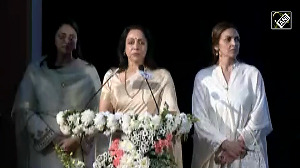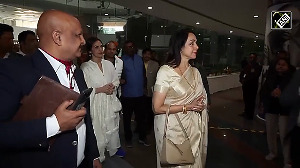The RBI must have a freer hand in navigating the economy through the strong and changing cross-currents on the balance of payments.
It is striking how quickly the over-hyped optimism over the evolving India economic story has given way to a reality check in general and pessimism over the economic outlook in particular.
To be fair, the macroeconomic news flow so far in the current fiscal year has largely been disappointing: growth is moderating, inflation is at a multiyear high, fiscal deficit (as percentage of GDP) is on an upswing, and the 'mighty' rupee, believe it or not, is weakening. And the current season for political madness only adds more pressure on the evolving economic dynamics by favoring questionable policies that disappointingly suspend markets.
Was the surge in capital inflows into India driven only by the attractiveness of the evolving India story? Or was there a pivotal role played by global factors that fuelled easier global liquidity, which in turn amplified the magnitude of capital inflows into the country? The answers to those questions are important in designing the likely policy response.
Capital inflows into India were attracted by the increasing domestic and global acknowledgement of the favourable structural economic shifts. However, the magnitude of these inflows was undoubtedly amplified by global factors. It is not a mere coincidence that spreads on emerging market debt peaked in 2003 and Indian equity market hit bottom that year.
Admittedly, there were local factors (such as the strong post-drought recovery in 2003) at play, but the key point remains that global risk appetite was on the increase in 2003-07, and India was a key recipient of capital inflows via several channels.
Indeed, all emerging markets received sizable capital inflows as global risk appetite surged, but the overwhelming jump in capital inflows (as percentage of GDP) into India was probably the highest among key emerging economies. With a small current account deficit, the overall balance of payments is estimated to have surged to an unprecedented $90 billion, (7.7 per cent of GDP) in the last fiscal year (official data have not yet been announced).
Apart from managing the current elevated inflation, the key policy challenge now is also managing domestic liquidity when the economy is experiencing a shock of significant slowdown in capital inflows while the current account deficit is widening. Forecasting capital inflows is a mug's game, but it is quite likely that the overall balance of payments will shrink notably in 2008-09.
The RBI has enough means up its sleeve to inject liquidity in a non-inflationary manner, in case domestic money market liquidity threatens to tighten in a sustained manner over and above what might be deemed desirable for managing inflationary expectations.
For example, it can, as a first line of response, unwind the hefty stock of sterilisation bonds. Additionally, it can start cutting the cash reserve ratio (CRR). Essentially, the situation could be in reverse play relative to the increased issuance of stabilisation bonds and CRR hikes in the last few years.
However, a natural outcome of the above approaches will be a weaker currency, as rupee liquidity that is injected will probably be greater than the increase in dollar liquidity.
One of the reasons for intervening in the foreign exchange market in recent years to avoid excessive rupee appreciation was perhaps a view that a sizeable portion of the increased capital inflows will be unsustainable, and that it is better to intervene and absorb the cost of that intervention rather than deal with unpalatable rupee movement.
Given the surge in capital inflows and assuming the absence of intervention, the rupee could have probably appreciated by over 30 per cent against the dollar, before reversing a good portion of that appreciation. Obviously, such a move would have been destructive.
To the extent the above scenario plays out, what should be done about improving the availability of dollars? The recent sizeable rupee depreciation against the dollar has been orderly, but it has more room to cover, especially if global crude oil prices continue to rise.
The rupee weakness is only reflecting the economy's adjustment to new realities. But it has given rise to talk about easing the restrictions on external commercial borrowings.
There are two key arguments put forward for an immediate easing of ECB restrictions (recall that these were meant to be a short-term measure): (1) they will increase dollar supply, thereby checking the pace and the magnitude of the rupee's depreciation against the dollar; and (2) revival in inflows will increase domestic demand, boosting overall economic growth.
There are several reasons for not rushing into easing the restrictions. First, the outlook for capital inflows remains uncertain.
The last thing policymakers should attempt is to go in for premature easing of restrictions on ECBs only to find their backs against the wall later on if capital inflows pick up or if oil prices fall meaningfully. India needs to be in the business of sustained opening up of markets rather than advertising the government's current mentality that favours killing markets.
Policymakers should be absolutely clear that an 'on-off-on' approach toward restrictions on capital inflows should be totally avoided. That, in turn, warrants policymakers to be sure about the evolving landscape for capital inflows and crude oil prices, views that remain subject to a high degree of uncertainty, suggesting maintaining the status quo on the ECB policy, at least for the time being.
Second, while the current jump in inflation is driven more by supply-side than demand-driven factors, a policy-induced boost to aggregate demand should be avoided for the time being. That restraint is even more important when one considers the expansionary stance of India's "real" fiscal dynamics.
Third, the industrial production data overstate the current moderation in growth. There is a high probability that the certain categories of output (for example, capital goods) are not being recorded properly. Still, growth slowing to even 7-8 per cent this year is not a bad outcome at all. Importantly, that outcome is closer to the economy's most likely realisable potential growth in the next two-three years.
Fourth, the long overdue correction in real estate is currently underway, and probably has more to run. Easing restrictions on ECBs will mess around with the ongoing adjustment, as real estate companies will be the first off the mark to increase overseas borrowing.
Fifth, easier and greater access to overseas funds will (again!) compromise the effectiveness of the current domestic monetary policy stance. The bottom line is that there will emerge a stronger case for eliminating the restrictions on ECBs, but now is not the best time for such a response.
Hopefully, the government has learnt from the experience of last couple of years, and will not make policymaking even more challenging for the RBI.
The author is Executive Director at JPMorgan Chase Bank, Singapore. The views expressed are personal






